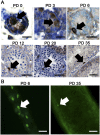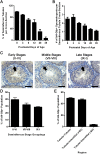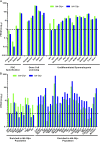Functional and molecular features of the Id4+ germline stem cell population in mouse testes
- PMID: 24939937
- PMCID: PMC4066404
- DOI: 10.1101/gad.240465.114
Functional and molecular features of the Id4+ germline stem cell population in mouse testes
Erratum in
- Genes Dev. 2014 Aug 1;28(15):1733
Abstract
The maintenance of cycling cell lineages relies on undifferentiated subpopulations consisting of stem and progenitor pools. Features that delineate these cell types are undefined for many lineages, including spermatogenesis, which is supported by an undifferentiated spermatogonial population. Here, we generated a transgenic mouse line in which spermatogonial stem cells are marked by expression of an inhibitor of differentiation 4 (Id4)-green fluorescent protein (Gfp) transgene. We found that Id4-Gfp(+) cells exist primarily as a subset of the type A(single) pool, and their frequency is greatest in neonatal development and then decreases in proportion during establishment of the spermatogenic lineage, eventually comprising ∼ 2% of the undifferentiated spermatogonial population in adulthood. RNA sequencing analysis revealed that expression of 11 and 25 genes is unique for the Id4-Gfp(+)/stem cell and Id4-Gfp(-)/progenitor fractions, respectively. Collectively, these findings provide the first definitive evidence that stem cells exist as a rare subset of the A(single) pool and reveal transcriptome features distinguishing stem cell and progenitor states within the mammalian male germline.
Keywords: Id4; germline stem cell; spermatogonia; spermatogonial stem cell; transcriptome.
© 2014 Chan et al.; Published by Cold Spring Harbor Laboratory Press.
Figures







References
-
- Barker N, van Es JH, Kuipers J, Kujala P, van den Born M, Cozijnsen M, Haegebarth A, Korving J, Begthel H, Peters PJ, et al. 2007. Identification of stem cells in small intestine and colon by marker gene Lgr5. Nature 449: 1003–1007 - PubMed
-
- Bentley KL, Shashikant CS, Wang W, Ruddle NH, Ruddle FH 2010. A yeast-based recombinogenic targeting toolset for transgenic analysis of human disease genes. Ann N Y Acad Sci 1207: E58–E68 - PubMed
Publication types
MeSH terms
Substances
Associated data
Grants and funding
LinkOut - more resources
Full Text Sources
Other Literature Sources
Medical
Molecular Biology Databases
